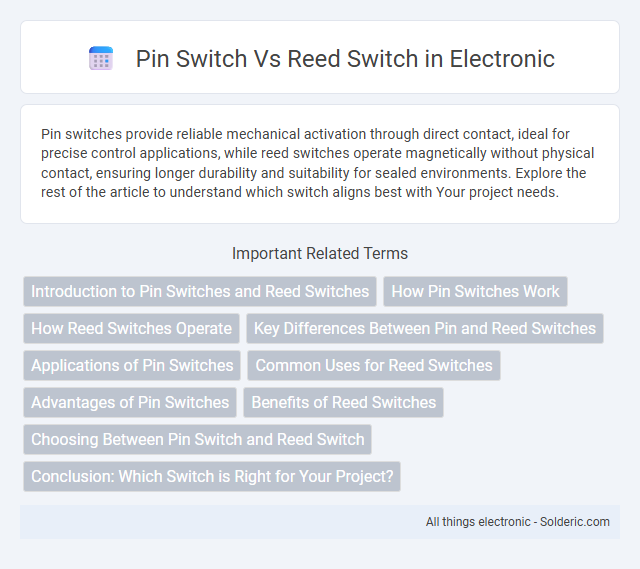Pin switches provide reliable mechanical activation through direct contact, ideal for precise control applications, while reed switches operate magnetically without physical contact, ensuring longer durability and suitability for sealed environments. Explore the rest of the article to understand which switch aligns best with Your project needs.
Comparison Table
| Feature | Pin Switch | Reed Switch |
|---|---|---|
| Operation | Mechanical contact activated by pin movement | Magnetically activated contacts enclosed in a glass tube |
| Durability | Moderate, susceptible to wear due to mechanical contact | High, sealed environment prevents contamination and wear |
| Switching Speed | Slower due to mechanical movement | Fast activation via magnetic field |
| Contact Type | Direct electrical contact via pin | Metal reeds inside glass tube contact magnetically |
| Common Applications | Keyboards, simple mechanical detection | Proximity sensors, isolated electrical circuits |
| Electrical Isolation | None, contact directly exposed | High, contacts sealed in glass, electrically isolated |
| Resistance to EMI | Low, susceptible to electromagnetic interference | High, magnetic operation reduces interference risk |
| Cost | Generally low cost | Moderate, higher than pin switches |
Introduction to Pin Switches and Reed Switches
Pin switches are mechanical components that detect the presence or absence of physical contact by closing or opening an electrical circuit when a pin is pressed or released. Reed switches consist of two ferromagnetic blades sealed in a glass envelope that close or open the circuit in response to an external magnetic field. Both switches are widely used for position sensing, security systems, and electronic device controls, with pin switches relying on physical pressure and reed switches on magnetic influence.
How Pin Switches Work
Pin switches operate through physical contact between conductive elements inside the switch housing, completing or breaking an electrical circuit when pressed or released. Unlike reed switches that rely on magnetic fields to close or open contacts, pin switches respond directly to mechanical pressure applied on the pin. Your choice between pin and reed switches depends on the required sensitivity and environmental conditions of your application.
How Reed Switches Operate
Reed switches operate by using two ferromagnetic blades sealed within a glass envelope that close or open an electrical circuit when exposed to a magnetic field. The magnetic force causes the blades to either attract and make contact or repel and separate, enabling precise, contactless switching. Your choice between a pin switch and a reed switch should consider this magnetic operation for applications requiring non-mechanical, durable, and reliable switching mechanisms.
Key Differences Between Pin and Reed Switches
Pin switches operate through physical contact triggered by mechanical movement, whereas reed switches utilize magnetic fields to open or close circuits without direct contact. Pin switches generally provide faster response times and higher durability in harsh environments, while reed switches offer lower power consumption and enhanced isolation from mechanical wear. The choice depends on specific application needs, considering factors like sensitivity, environmental conditions, and lifespan.
Applications of Pin Switches
Pin switches are widely used in industrial machinery for position sensing and limit detection due to their durability and ability to handle high mechanical stress. Common applications include elevator safety systems, conveyor belt automation, and heavy equipment controls where precise mechanical actuation is required. Your choice of a pin switch ensures reliable operation in harsh environments, making them ideal for rugged, high-impact settings.
Common Uses for Reed Switches
Reed switches are commonly used in security systems for door and window sensors due to their reliable magnetic actuation and long lifespan. They frequently appear in proximity sensing applications in consumer electronics, such as smartphones and laptops, to detect lid closure or cover positioning. Industrial machinery also relies on reed switches for position sensing and limit switching because of their high sensitivity and maintenance-free operation.
Advantages of Pin Switches
Pin switches offer precise mechanical actuation with high durability, making them suitable for applications requiring reliable, long-term performance. Their compact design allows for easy integration into small or confined spaces, enhancing versatility across electronic devices. Compared to reed switches, pin switches generally provide faster response times and greater resistance to vibration and shock, ensuring consistent operation in demanding environments.
Benefits of Reed Switches
Reed switches offer significant benefits including low power consumption, long operational life due to minimal contact wear, and excellent reliability in harsh environments. Their hermetically sealed design provides superior resistance to dust, moisture, and corrosive elements, ensuring consistent performance in industrial and automotive applications. Additionally, reed switches enable precise proximity sensing with fast switching speeds and high sensitivity, making them ideal for secure and efficient control systems.
Choosing Between Pin Switch and Reed Switch
Choosing between a pin switch and a reed switch depends on your application's specific requirements for durability, sensitivity, and environmental exposure. Pin switches offer reliable mechanical actuation with physical contact, ideal for devices needing precise manual input, while reed switches operate contactlessly through magnetic fields, providing better longevity in sealed or hazardous conditions. Your decision should consider factors like switching speed, exposure to dirt or moisture, and the need for non-contact operation to ensure optimal performance.
Conclusion: Which Switch is Right for Your Project?
A pin switch offers precise mechanical actuation ideal for applications requiring direct physical contact, while a reed switch provides reliable magnetic activation suited for sealed or remote sensing environments. Your choice depends on factors like environmental conditions, desired sensitivity, and space constraints. For projects demanding durability and minimal contact wear, a reed switch is preferable; for straightforward mechanical triggering, a pin switch is the optimal solution.
pin switch vs reed switch Infographic

 solderic.com
solderic.com